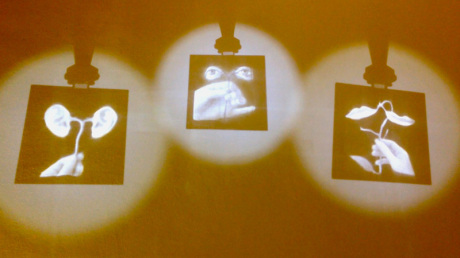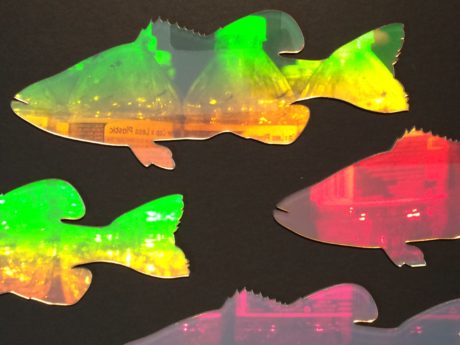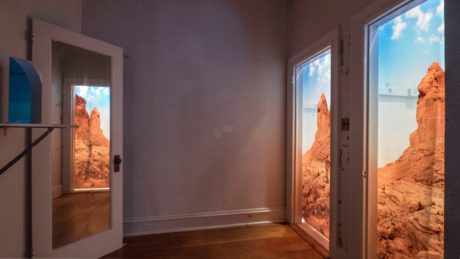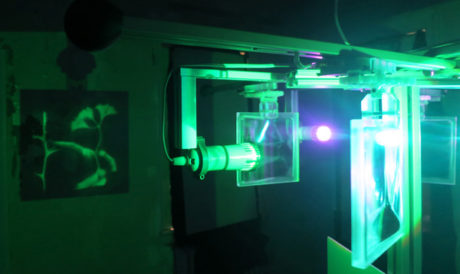September, 2015

Visions in the dark – Ken Dunkley
Pioneer holographer Ken Dunkley presents three laser transmission holograms
Renowned for creating Thoughts, 1973—the first recorded example of independent “serially connected” visual spaces. The first visual space contains a second that is completely independent of the first, and it in turn contains a third independent space. And so on. Thoughts is recognized as the first art hologram to fully utilize the holographic medium and has been credited as one of “the pivotal holograms in the development of holography as an art form”
Featured at MoMA in 1977, Dunkley has since then expanded his optical odyssey to include Space Children, and the interactive hologram, Homecoming.
Experience these amazing works together for the first time at the Holocenter Summer Museum
New Branches on the Tree of Life – Matt Brand
Sometime in the late Renaissance, painters began to depict the patron saint of troubled vision offering her disembodied eyes to the viewer. In the most striking of these paintings, her eyes grow on a stalk like flowers or fruits waiting to be harvested. This installation connects that vision to a not-so-far future, when disembodied transplant organs will also be grown, harvested, and offered to new kinds of patrons. Th e imagery is rendered in morphing images via lumography, a medium developed by the artist. Clear lenses with undulating optical surfaces rearrange light rays into pictures, the same way that moving water makes patterns of sunlight at the bottom of a fountain.
e imagery is rendered in morphing images via lumography, a medium developed by the artist. Clear lenses with undulating optical surfaces rearrange light rays into pictures, the same way that moving water makes patterns of sunlight at the bottom of a fountain.
Matt Brand is an artist and scientist on extended exile from New York in Cambridge, Massachusetts. His studio, Zintaglio Arts, specializes in coaxing new and unexpected visual experiences from humble materials. Another studio invention — specular holography — can be seen in a permanent installation at the Museum of Mathematics, NY.

Light Ocean: and what the poor fish ate – Betsy Connors
Inspired by the Great Pacific Garbage Patch this installation creates a holographic juxtaposition with a strong message. The installation Light Ocean is work-in-progress which continues Connor’s long series of holographic installations inspired by the environment. Bring together hologram elements with computer-controlled devices to play with light or motion these installations produce a sense of dynamics in nature.
Connors studied and taught at MIT’s Media Lab for almost two decades and has exhibited her work internationally. She has recently re-built her company/lab ACME Holography in the Boston area.
The master holograms for Light Oceans were created at the HoloCenter’s AIR program with Harris Kagan at Ohio State. The transfers are being created at ACME Holography.
August and September, 2015

Doorway to Nubia, 2015 – Bryan Whitney
An important site in Egyptian mythology is revealed in 3D by looking into the set of mirrors.
Jebel Barkal is a sandstone butte on the Nile river in Northern Sudan in a region called Nubia. When Egyptians conquered Nubia around 1500 B.C., they identified Jebel Barkal as the birthplace of their god, Amun. They further perceived the colossal spire-like pinnacle on the butte’s southern cliff as evidence of Egyptian royal power and authority over the region, as it resembled the Uraeus – a rearing cobra – which was worn on the front of Pharaoh Thutmose III’s crown. Consequently, the site was considered sacred and many temples and pyramids were built there.
The technique of viewing 3D images with mirrors is modeled on the original method first used by Sir Charles Wheatstone in 1838.
July & August – then at Fort Jay in September, 2015

RENDER, Weekends from July 11
Almost every facet of our lives is now grist for the mill of government and corporate surveillance and data mining. To this network of systems, we exist only as sets of quantified information — not as creative, freely operating beings. Maximus Clarke‘s 3D video installation, RENDER, is a depiction of human personhood under the reifying gaze of the new panopticon.
In computer science, reification is the process of creating a data model for classifying all aspects of a subject. In gestalt psychology, reification is the perception of a complete form based on fragmentary information: for example, the apprehension of depth in a stereo image. In Marxist theory, reification occurs when social relations, and those involved in them, are reduced to mere objects.
RENDER will comprise an installed structure in which the viewer sees three-dimensional images of a woman and a man, analyzed from all angles by panoptic observation, and deconstructed into pixelated grids of pure information. Their individual selves, and their relationship, are thereby reified: rendered into numeric values, abstractly modeled, and dis-integrated, as their lives are transformed at a granular level by an omniscience that cannot be contested. Will the private self endure and be renewed, or is it just a ghost in this machine?
August, 2015
The HoloCenter will be the site of the third Stereoscopic Camera Obscura by Jose Vargas. The outside world is overlaid as a 3D projection, explore this space inside and become part of the time-lapse capture.
Jose Vargas is an artist/photographer/computer nerd. His work uses photography, programming, hardware and sculpture to deal with the collision between landscape and place and culture and technology. He attended the University of Puerto Rico for undergraduate studies in Art History, and the School of Visual Arts, where he obtained an MFA in Computer Art.Vargas presented this project and his work on September 26, 3-5pm

‘Art for Time Travelers: a 4D Video Sculpture of the Lower Manhattan Shoreline through Time, Extracted from Archival Movie Footage‘ by Robert Bowen
This unique work functions as an instrument to view the city, as it examines the iconic geopolitical landscape of lower Manhattan in ways not previously experienced. One day in 1903, the filmmaker, J.B. Smith, on assignment for the Thomas A. Edison Co. of West Orange, NJ, took a boat ride around Lower Manhattan. This project takes off from a digital stereoscopic conversion of what Smith saw, what he didn’t see, what we see now, what’s missing, and what’s been added since. Think of it as a 4D diachronic moving panoramagram, a cinema of variation for both eyes, and where more than one timeframe can be perceived simultaneously. It relates to the tradition of the montage city film, but it encompasses all timeframes. By varying the modes of perception we experience trans-temporal drift, and a heightened sense of the sculptural and geopolitical volumes that we inhabit. New York as the iconic sky scraper city is revealed to be a panopticon of varied urban renewals culminating in postmodern hyperspace, geopolitical tragedies, and the entropic effects of climate change.
This installation is derived from the upcoming film, Recovering Lost Architectural & Cinematic Volumes of Lower Manhattan (1903-2015); A Sonic Stereoscopic Space-Time Performance Work that will premiere in early 2016.
On Saturday September 26, @4pm Robert Bowen will give a talk about the process of creating this 4D video sculpture from Archival footage.
July, 2015
Steve Pavlovsky took us behind the scenes of his liquid light shows. Open the studio and workshops focuses on the use of oils, and other organic hands-on projection techniques.
These workshops give participants an opportunity to experiment with making their own liquid light projects. While making light projections you will also learn some of the history about this art form and preceding ideas, and progress
through the 70s, 80s, and what is happening now.
Steve Pavlovsky will be creating the next part of his online workshop tutorial series during his HoloCenter residency. Part 1 is online here
June, 2015
Exploring both two and three dimensional imagery Yandell Walton creates a haunting experience of presence. Photo collage and an interactive projection installation are brought together to create this intriguing experience. This work was developed during her residency at the Holocenter Summer
Museum on Governors Island responding to the history and architecture of
the site. The installation expands on Walton’s ‘Absent Presence‘ presented at the Luxlumin Festival in 2014.
Yandell Walton‘s practice utilizes projection to investigate ideas around impermanence and
mortality. Her work aims to blur the distinction between the actual and the virtual
through the interception of moving image and architecture or object. Exhibiting regularly in
galleries and public spaces both in her home town Melbourne Australia and Internationally Yandell’s work consistently pushes the boundaries of the medium incorporating interactive elements, collaborations and new technologies. Recent exhibitions in include an interactive public artwork presented by
Experimenta for Melbourne Festival, VIVID Festival Sydney, ISEA
(International Symposium of Electronic Art) and White Night Festival
Melbourne and Digital Graffiti in Alys Beach Florida where she won ‘best of show’.
2016 Space:Light Installations


